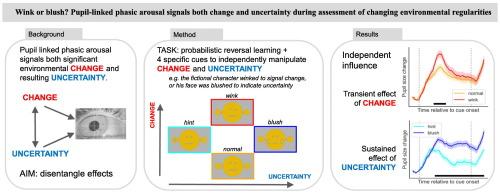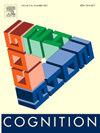Wink or blush? Pupil-linked phasic arousal signals both change and uncertainty during assessment of changing environmental regularities
IF 2.8
1区 心理学
Q1 PSYCHOLOGY, EXPERIMENTAL
引用次数: 0
Abstract
One main cornerstone of adaptive behavior is belief updating, whereby new and unexpected observations lead to the updating of learned associations between events, behaviors and outcomes. This process necessitates the detection of changed environmental contingencies which in turn leads to uncertainty about the environmental regularities. Change and uncertainty are thus inherently linked, and both constructs have been linked to pupil size changes, which might reflect activity in neural networks underlying belief updating. Thus, in our study, we aimed to disentangle the effects of change and uncertainty on pupil-linked arousal. We used a probabilistic reversal learning task, where participants had to act according to changing preferences of a fictional character, and used specific cues to independently manipulate the level of change and uncertainty (e.g. the fictional character winked for signaling change, or his face was blushed to indicate uncertainty). We found that when the cues triggered the same amount of uncertainty, larger levels of change in beliefs led to a transient increase in pupil size during cue processing. In contrast, when the cues signaled a similar amount of change, then increased belief uncertainty was associated with a sustained increase in pupil size, extending in time beyond cue processing. Thus, change and uncertainty exerted independent influence on pupil-linked arousal, possibly reflecting the activity of different neural networks, and highlighting the need to disentangle the effects of these overlapping but distinct theoretical constructs.

眨眼还是脸红?在评估变化的环境规律时,瞳孔相关的相位觉醒信号既变化又不确定
适应性行为的一个主要基础是信念更新,即新的和意想不到的观察导致事件、行为和结果之间的习得关联的更新。这个过程需要检测变化的环境偶然性,这反过来又导致了环境规律的不确定性。因此,变化和不确定性是内在联系的,这两种构念都与瞳孔大小的变化有关,这可能反映了信念更新背后的神经网络活动。因此,在我们的研究中,我们旨在解开变化和不确定性对瞳孔相关觉醒的影响。我们使用了一个概率反转学习任务,在这个任务中,参与者必须根据一个虚构角色不断变化的偏好采取行动,并使用特定的线索来独立操纵变化和不确定性的水平(例如,虚构角色眨眼表示变化,或者他的脸脸红表示不确定)。我们发现,当线索触发相同数量的不确定性时,在线索处理过程中,更大程度的信念变化导致瞳孔短暂增大。相比之下,当线索暗示了相似数量的变化时,信念不确定性的增加与瞳孔尺寸的持续增长有关,并随着时间的推移延伸到线索处理之外。因此,变化和不确定性对瞳孔相关的觉醒产生了独立的影响,可能反映了不同神经网络的活动,并强调需要解开这些重叠但不同的理论结构的影响。
本文章由计算机程序翻译,如有差异,请以英文原文为准。
求助全文
约1分钟内获得全文
求助全文
来源期刊

Cognition
PSYCHOLOGY, EXPERIMENTAL-
CiteScore
6.40
自引率
5.90%
发文量
283
期刊介绍:
Cognition is an international journal that publishes theoretical and experimental papers on the study of the mind. It covers a wide variety of subjects concerning all the different aspects of cognition, ranging from biological and experimental studies to formal analysis. Contributions from the fields of psychology, neuroscience, linguistics, computer science, mathematics, ethology and philosophy are welcome in this journal provided that they have some bearing on the functioning of the mind. In addition, the journal serves as a forum for discussion of social and political aspects of cognitive science.
 求助内容:
求助内容: 应助结果提醒方式:
应助结果提醒方式:


